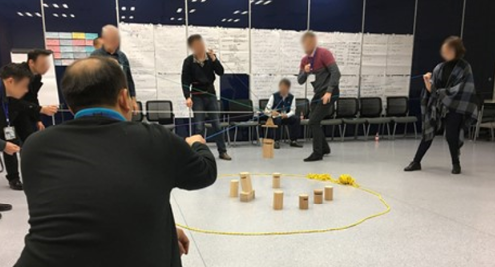Why we need team building is a very valid question. Millions of teams function wonderfully without ever having done any team building. So why spend money and invest a lot of time in it? On the one hand, I am a fan of the motto “Don’t solve a problem that doesn’t exist”, but on the other hand, the questions arise: Isn’t improvement always possible? Shouldn’t we continually strive to improve – not only as individuals but also as a team?
So when does team building make sense? Indeed, when there are “creaks” in the team when there are problems under or above the surface. The reasons for this are manifold: different perceptions or opinions on various work topics (e.g. how a problem should be solved) are among the most common causes.
Here, team building under professional guidance can support the team in making differences visible, understanding them and developing ways to deal with them productively. The first step is always to build understanding with the other person.
Often this is not possible in the hustle and bustle of daily business. With a little distance from daily stress, in a pleasant environment and with the support of a coach, things look different.
But even if there are no problems (or they are not perceived), it can be beneficial to take some “time out” as a team and reflect on your successes and potential for improvement.
Often it is simply about experiencing something fun together. Such shared experiences strongly affect our subconscious, create trust and strengthen the feeling of togetherness.
What types of team building are there?
I distinguish between two types of team building: experience-oriented and reflective.
Experience-oriented team building
Here – as the name suggests – the focus is on the shared experience. It is crucial to find an activity that all team members enjoy, and that can the team can carry out together. It is often challenging, especially when there are very different interests. Only some people want to go hiking, for example – which is a classic activity in adventure-oriented team building.
Finding an everyday activity that all team members agree with can be the first part of team building. Examples of such activities are Escape-the-room, city puzzle rally, indoor climbing, outdoor climbing garden, making a film, crime dinner, graffiti, cooking together, building a marble run, etc.
It is not advisable to engage in activities where the focus is not on being together but against each other, as can be the case with paintball.
Reflexive
In reflexive team building, the focus is on reflecting on the team’s cooperation. I like to ask these three questions:
1. what are we proud of as a team?
2. what is going well?
3. where do we have the potential for development as a team?
The conscious discussion of what is going well and what the team is proud of can generate positive energy and strengthen trust in the group.
In contrast to experience-oriented team building, the focus here is on a rational examination of team cooperation. Subsequently, measures are developed and agreed on how the collaboration will be shaped in the future.
But even with this type of team building, fun should be addressed. Team exercises are an excellent way to reflect on cooperation, laugh, and have fun together. We have a wealth of such exercises in our repertoire and use them in every team-building session according to the team’s needs. An example of this can be seen in the following picture, the “Tower of Babel”:

Conclusion
Whatever type of team building you choose – strengthening the team is always a good investment for the future. It is essential to know what you expect from a team building event and find a format that suits you best. We will be happy to advise you and work with you to develop a solution tailored to your needs. With this in mind – have fun with your next team building.


Recent Comments